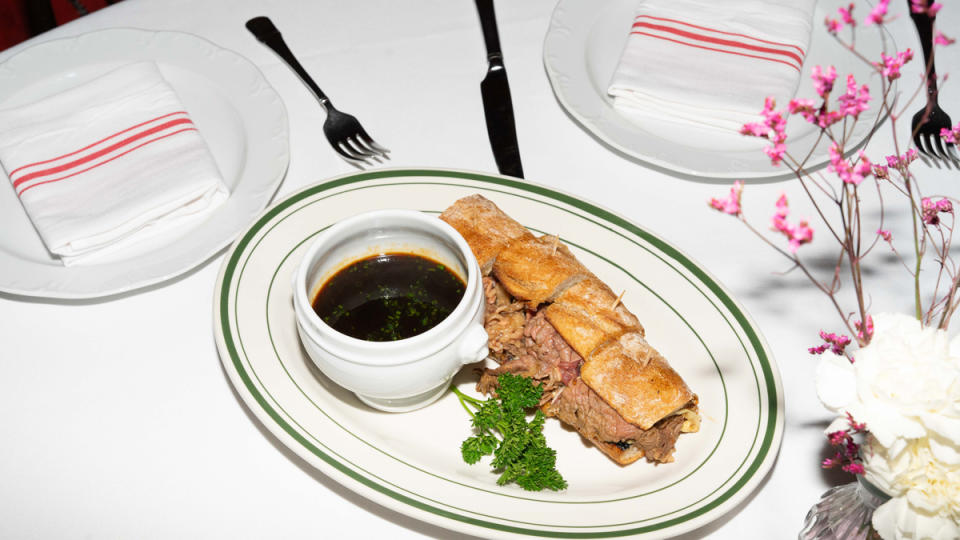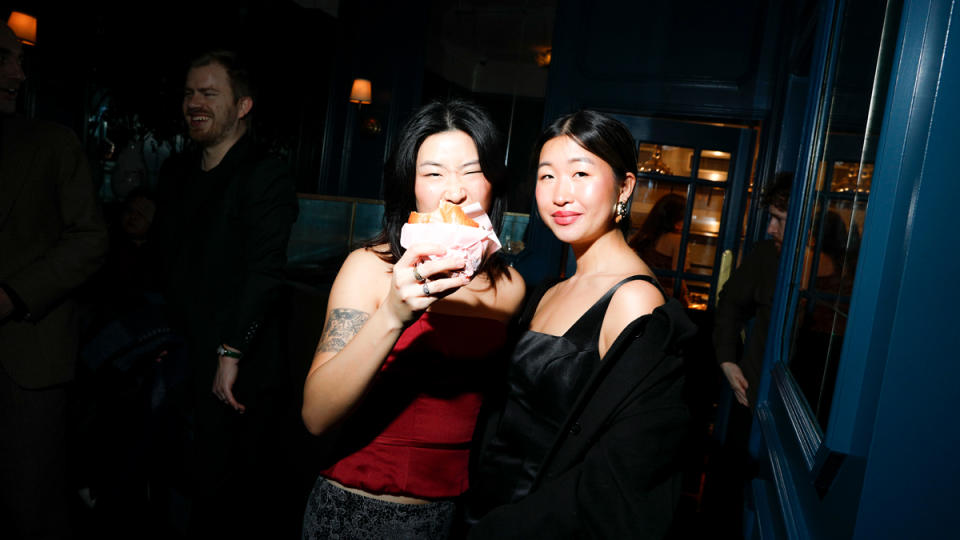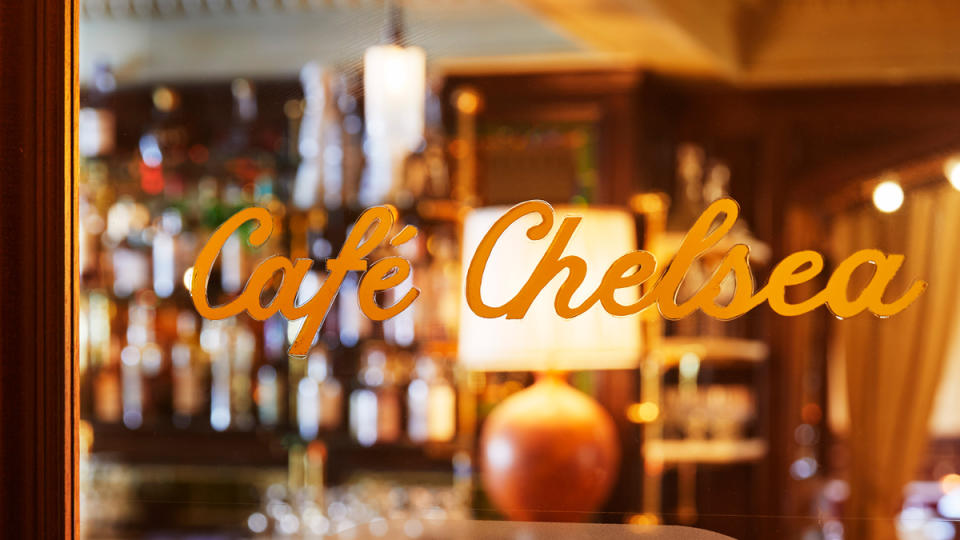Inside the Glorious Return of N.Y.C.’s Late-Night Dining Scene

On the first warm night of spring, around 11 p.m., the dining room at Blue Ribbon Brasserie sat mostly empty. And it didn’t bother me a bit, since I had coupe filled with shrimp cocktail, a flute brimming with crémant, and half a fried chicken set before me.
Brothers Eric and Bruce Bromberg opened the restaurant in 1992 as an ode to Paris’ 24-hour Au Pied de Cochon. “We wanted to do something for people who didn’t have normal schedules,” says Bromberg. “And we kind of did it for ourselves, to have a place where we could go and eat what we wanted whenever we wanted.”
More from Robb Report
Watch: How This Pastry Chef Makes Her Whimsical Corn Dessert at N.Y.C.'s Lysée
Jean-Georges Vongerichten Is Opening a Members Club in New York City
For Blue Ribbon’s first six months, they did 10 covers each night after midnight, but a 1993 Gael Green review and a word-of-mouth campaign among the city’s cooks soon had their dining room cranking until 4 a.m. and filled with chefs, musicians, actors, comedians, and all sorts of people of the night. “We weren’t the only game in town, but for 30 years, we were the preeminent game in town, the only place you could get a real dining experience that late,” Bromberg says. “Covid kicked everything into scrambled eggs. We basically had to start over, but we’re on our way back.”
During the pandemic, New York lost its late-night edge. Lots of cooks and creatives left the city, at least in the thick of lockdowns. The kids took their parties underground, and everyone else had little reason to venture out after sunset. “People just got so used to having nothing to do in the evening. It’s like everything sort of shifted in some Twilight Zone,” Bromberg says.
Even as the city yawned back to life, restaurants maintained a conservative curfew. Kitchens that would have cooked until 11 p.m. stopped taking orders two hours earlier; 24-hour joints locked their doors at midnight. Blue Ribbon Brasseries cut its hours to 2 a.m. and nearby Blue Ribbon Sushi from 2 a.m. to midnight.

But, in the last year, great late-night dining has started to re-emerge. And I’m not talking diners, Papaya Dog, taco trucks, or old-school spots like JG Melon (still open until 3 a.m. on the Upper East Side). Rather, there’s a new breed of Bromberg-ian, chef-driven, late-ish night menus that signal a city that’s edging into its old, wanton ways after dark.
Jean’s, the buzzy, might-as-well-be-a-private-club from Max Chodorow and Ashwin Deshmukh keeps its kitchen cranking until 2 a.m. on Fridays and Saturdays with a menu of its best hits: the bistro burger, tagliatelle Bolognese, and the city’s most talked about chocolate chip cookie. Think of it as an after-hours pasta party.
Simon Kim’s Michelin-starred Cote now serves night-owl diners its generous, celebratory Butcher’s Feast—with its four cuts of USDA Prime and American Wagyu, banchan and all the sides—Thursday to Sunday until 1 a.m. At that hour, you might as well add on some Japanese A5.
“To me, introducing the late-night menu at Cote was all about nostalgia,” Kim says. “I have such special memories of late-night dining with my team and industry colleagues at Blue Ribbon, Buvette, and in K-town, which has always been such a coveted destination for the after-hours crowd. It was important to me that we were able to offer a similar feeling but with an elevated approach.”
Last year, too, Ellia and Junghyun Park opened casual Seoul Salon in the heart of Koreatown. After a cocktail party in January, friends and I trekked through a downpour to 33rd Street and split fried shrimp and cheese (how are you supposed to resist that after a few drinks), fried chicken bites streaked with gochujang, and the jokbal platter—really more of a tower overflowing with braised pork trotter, sundae (a.k.a. blood sausage), all the sauces, and endive leaves. They’re open until midnight five days a week and until 2 a.m. Fridays and Saturdays, with last call an hour before closing time.

Ten blocks south at the Chelsea Hotel, Cafe Chelsea takes orders until midnight Thursday through Sunday, and on a visit in February, there wasn’t an empty bar seat in the bistro. Around 11 p.m., at least a dozen hopeful diners, young things and tourists, milled around the host station waiting to be seated. I squeezed into a two-top for Martinis and a near two-hour meal of oysters, artichokes, chef Derek Boccagno’s clever sheet of ravioles du dauphiné, and, like a good hedonist, a cheeseburger stacked with raw onions and dripping with mornay sauce.
Eyal Shani and Shahar Segal brought Tel Aviv’s Port Sa’id to downtown New York last summer. Rotating DJs mix vinyl (I visited on a ‘70s-heavy night) from a stage until the wee hours, a disco ball hangs overhead, and the kitchen sends out fresh, cravable Mediterranean dishes, dips upon dips, and fortifying hunks of challah. It’s not quite a night club, nor exclusively a restaurant, but most definitely a scene. Plan on dancing, even if it’s just in your seat. “We come from a different culture,” says Segal. “Dinner is not only sitting down and having food, it’s a social gathering. It’s an emotional event, a place where life happens.”
The goal is to make guests want to stay forever, he says. The idea of turning tables—standard New York protocol—fills Segal with disgust, and the restaurant’s hours on Google are a mere suggestion. If the party’s still on at 2 a.m. or 4 a.m., nobody will go home.
“It feels great, like we’re getting back to actual New York,” says Angie Mar, who last fall, converted her jackets-required and tasting menu-only Les Trois Chevaux into glammed up, lively Le B. At first, says Mar, everyone wanted 6 p.m. reservations. Now, the restaurant’s 9 p.m. tables are filling, and guests drop into the bar at 11:30 for a drink and a quick bite of pork and duck terrine, Dungeness crab Wellington, or one of nine burgers Mar serves each night.

Drinking Champagne at Le B and splitting five or so courses (may I recommend onions Nancy, sturgeon Charlemagne, salad Chinoise, liver and onions, the Wellington, and a petite bowl of ice cream) from 9:30 p.m. to midnight does feel made for this moment. It’s neither elbow-room-only Beatrice Inn, where Mar would have to kick out revelers at 2 a.m., nor Les Trois Chevaux, which didn’t allow for a spontaneous drop-in.
But it does signal a shift. Early in her career, Mar cooked with April Bloomfield at raucous the Spotted Pig, which stayed open until 2 a.m. She couldn’t leave work for another two hours and would often hit Chinatown or now-shuttered the Harrison afterwards. Last summer, The Golden Swan opened in the former Spotted Pig space, and their kitchen serves tuna carpaccio, Dover sole, and steak frites until midnight on weekends. With higher-end dining, the party just stops sooner now.
“The new late-night for me is 1 a.m.,” says Mar. “I sound so suburban.”
From Bromberg, too, 10 p.m. is “as late as it gets” unless he’s working at one of his restaurants. “People now orient their experiences around a condensed day. It starts later and ends earlier. We do very well until two o’clock, but we haven’t seen much demand after that,” says Bromberg, who thinks the city still needs a year or two before it will demand 4 a.m. dining. “We talk about it almost every day, how do we get back to our New York normal.”
At Blue Ribbon, in the time it took for my date to finish a fried drumstick, I looked up and noticed a host seating a two-top across the dining room. Fifteen minutes later, all the bar seats had filled, and by the time we left at midnight, there was only one vacant table. The rest had started to crowd with watercress salads, seafood towers, and steak au poivre. I had promised Bromberg I would come in around 1:30 a.m. to observe the crowd, but I had eaten and sung along to Blondie and witnessed a restaurant transform on the fine line between a Tuesday night and a Wednesday morning. And after a short walk home, I fell asleep.
Best of Robb Report
Why a Heritage Turkey Is the Best Thanksgiving Bird—and How to Get One
The 10 Best Wines to Pair With Steak, From Cabernet to Malbec
Sign up for Robb Report's Newsletter. For the latest news, follow us on Facebook, Twitter, and Instagram.


